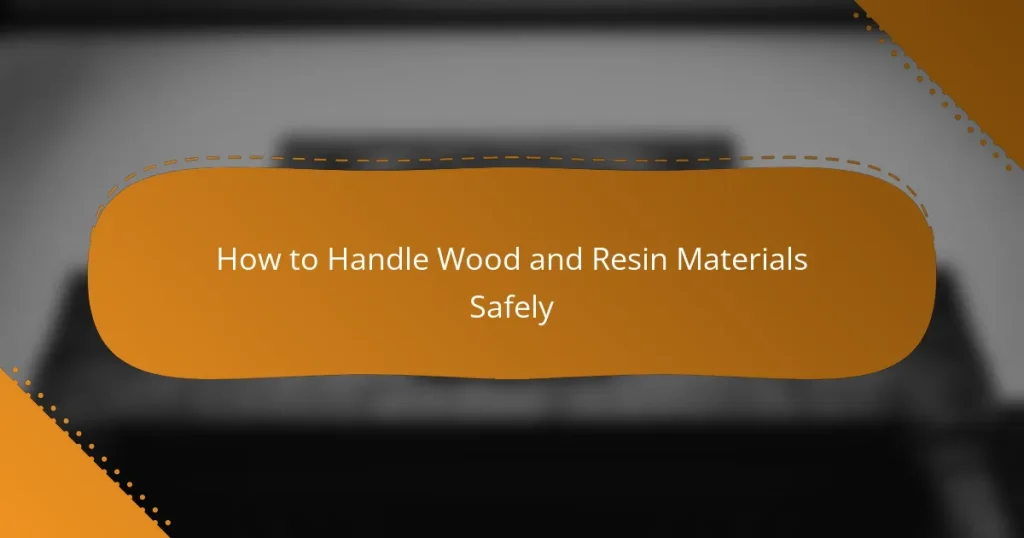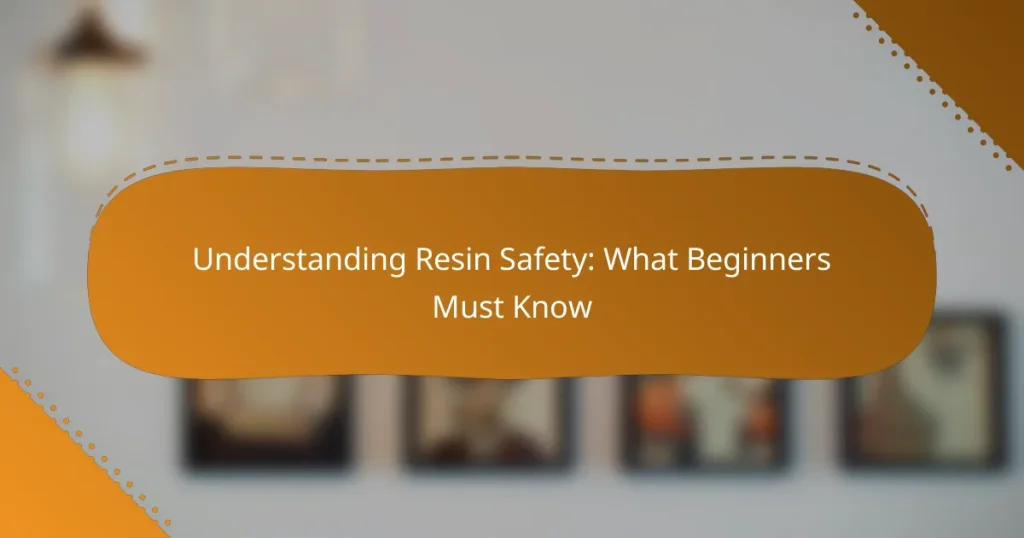Engaging in woodworking and resin crafts can be rewarding, but it is essential to prioritize safety to prevent accidents and health hazards. By utilizing personal protective equipment, maintaining a tidy workspace, and following proper tool handling techniques, you can create a safer environment for your projects. Additionally, ensuring adequate ventilation and safe storage of materials further enhances safety while working with potentially hazardous substances.
7 Essential Safety Tips for Beginner Woodworkers
How to Set Up a Safe Woodworking Space for Beginners
7 Common Safety Mistakes Beginners Make in Woodworking
How to Handle Wood and Resin Materials Safely
Protective Gear: What Every Beginner Woodworker Should Wear
Understanding Resin Safety: What Beginners Must Know
What are the essential safety practices for woodworking and resin crafts?
Essential safety practices for woodworking and resin crafts include using personal protective equipment, maintaining a clean workspace, following proper tool handling techniques, ensuring adequate ventilation, and storing materials safely. These practices help prevent accidents and health hazards while working on projects.
Use personal protective equipment (PPE)
Wearing appropriate personal protective equipment is crucial in woodworking and resin crafts. This typically includes safety goggles, dust masks, gloves, and hearing protection. Each piece of equipment serves to protect against specific hazards, such as flying debris, harmful dust, and loud noises.
When selecting PPE, ensure it meets relevant safety standards. For example, look for goggles that provide a snug fit and are rated for impact resistance. Always replace any damaged or worn-out equipment to maintain safety.
Maintain a clean workspace
A clean workspace reduces the risk of accidents and injuries. Regularly remove wood shavings, resin spills, and other debris that can cause slips or falls. Use a broom or vacuum designed for fine dust to keep the area tidy.
Organize tools and materials to prevent clutter. Designate specific areas for cutting, sanding, and mixing to minimize cross-contamination and enhance efficiency. Implement a routine clean-up schedule to ensure the workspace remains safe and functional.
Follow proper tool handling techniques
Proper tool handling techniques are essential for safe woodworking and resin crafting. Always read the manufacturer’s instructions before using any tool and ensure you are familiar with its operation. Use tools for their intended purpose to avoid accidents.
When using power tools, maintain a firm grip and keep hands away from moving parts. Always unplug tools when changing blades or bits, and use push sticks or guides to keep fingers at a safe distance from cutting edges.
Ensure proper ventilation
Proper ventilation is vital when working with wood and resin to minimize exposure to harmful fumes and dust. Work in a well-ventilated area, such as a garage with open windows or a dedicated workshop with exhaust fans. If necessary, use a respirator rated for organic vapors.
Consider using air filtration systems to capture airborne particles and improve air quality. Regularly check and replace filters to maintain optimal performance and ensure a safe working environment.
Store materials safely
Safe storage of materials is crucial to prevent accidents and health risks. Store wood and resin in a dry, cool place away from direct sunlight to prevent degradation. Keep hazardous materials, such as solvents and adhesives, in clearly labeled containers and out of reach of children.
Implement a system for organizing materials, such as shelving or bins, to reduce clutter and enhance accessibility. Regularly inspect stored items for damage or expiration and dispose of any unusable materials according to local regulations.
How can you prevent accidents while woodworking?
To prevent accidents while woodworking, prioritize safety through proper planning and adherence to best practices. This includes using personal protective equipment (PPE), maintaining a clean workspace, and following established safety protocols.
Implement a safety checklist
A safety checklist is a practical tool to ensure all necessary precautions are taken before starting any woodworking project. Include items such as checking that all tools are in good condition, verifying that safety gear is worn, and ensuring the workspace is free of hazards.
Regularly updating the checklist can help accommodate new tools or techniques. Consider using a digital format for easy access and modification, allowing for quick adjustments as needed.
Conduct regular equipment inspections
Regular equipment inspections are crucial for maintaining safety in woodworking. Check tools for wear and tear, ensuring blades are sharp and free of damage, and that electrical components are functioning properly.
Establish a routine inspection schedule, such as monthly or quarterly, depending on usage frequency. Document findings and repairs to track equipment condition over time, which can help prevent accidents caused by faulty tools.
Keep emergency contacts accessible
Having emergency contacts readily accessible is vital in case of an accident. Create a list of local emergency services, including hospitals and poison control, and post it in a visible area of your workspace.
Additionally, ensure that all individuals working in the area are aware of these contacts and know how to respond in an emergency. Regularly review and update this information to ensure it remains current and effective.
What are the best tools for safe woodworking?
The best tools for safe woodworking include those designed with safety features, ergonomic designs, and effective dust management systems. Selecting the right tools can significantly reduce the risk of accidents and improve overall comfort during woodworking projects.
Use safety guards on power tools
Safety guards are essential components of power tools that protect users from accidental contact with blades and moving parts. Always ensure that guards are in place and functioning before operating any power tool.
Regularly inspect safety guards for wear or damage, and replace them if necessary. Familiarize yourself with the specific safety features of each tool, as they can vary widely between models and manufacturers.
Choose ergonomic hand tools
Ergonomic hand tools are designed to minimize strain on the body, making them safer and more comfortable to use for extended periods. Look for tools with padded grips, balanced weight, and shapes that fit the natural contours of your hands.
Using ergonomic tools can help prevent repetitive strain injuries, which are common in woodworking. Consider investing in tools that reduce the need for excessive force, such as ratcheting wrenches or lever-action clamps.
Invest in quality dust collection systems
A quality dust collection system is crucial for maintaining a safe woodworking environment by reducing airborne dust and debris. These systems help protect your respiratory health and keep your workspace clean.
When selecting a dust collection system, consider factors such as the size of your workspace, the types of materials you work with, and your budget. A system that captures fine particles is ideal, as it can significantly lower the risk of respiratory issues over time.
What safety measures are specific to resin crafts?
Safety measures for resin crafts are crucial to prevent health risks and ensure a safe working environment. Key practices include using personal protective equipment, ensuring proper ventilation, and adhering to manufacturer instructions.
Use gloves and masks when handling resin
Wearing gloves and masks is essential when working with resin to protect your skin and respiratory system from harmful chemicals. Nitrile gloves are recommended as they provide a good barrier against resin exposure, while masks with appropriate filters can help prevent inhalation of fumes.
Ensure that the gloves fit well and are free from any tears or damage. Replace them if they become contaminated or compromised during your project.
Work in a well-ventilated area
Good ventilation is critical when working with resin to minimize the inhalation of toxic fumes. Ideally, set up your workspace outdoors or in a garage with open windows and doors to allow fresh air to circulate.
If working indoors, consider using fans to increase airflow and exhaust systems to help remove any harmful vapors. Aim for a space that is free from dust and other contaminants to maintain a clean working environment.
Follow manufacturer guidelines for resin products
Each resin product comes with specific guidelines that outline safe handling and usage practices. Always read and follow these instructions carefully to avoid accidents and ensure the best results.
Pay attention to recommended mixing ratios, curing times, and any specific safety warnings. Adhering to these guidelines not only enhances safety but also improves the quality of your finished project.
What are the common hazards in woodworking and resin crafts?
Common hazards in woodworking and resin crafts include physical injuries, chemical exposure, and respiratory issues. These risks arise from the tools used, materials handled, and the environment in which the work is performed.
Physical injuries
Physical injuries in woodworking and resin crafts often result from improper tool use or lack of protective gear. Common injuries include cuts, lacerations, and punctures from sharp tools, as well as strains from lifting heavy materials.
To minimize these risks, always use appropriate personal protective equipment (PPE) such as gloves, safety goggles, and sturdy footwear. Ensure that tools are well-maintained and used according to manufacturer guidelines.
Chemical exposure
Chemical exposure is a significant hazard when working with resins and certain wood finishes. Many of these substances can emit harmful fumes or cause skin irritation, necessitating careful handling and ventilation.
Always read the safety data sheets (SDS) for materials used and work in a well-ventilated area. Consider using low-VOC (volatile organic compounds) products to reduce harmful emissions.
Respiratory issues
Respiratory issues can arise from inhaling dust, fumes, or particles generated during woodworking and resin crafts. Prolonged exposure can lead to serious health problems, including asthma or chronic obstructive pulmonary disease (COPD).
To protect your respiratory health, use dust collection systems, wear masks rated for fine particles, and ensure adequate airflow in your workspace. Regularly clean the area to minimize dust accumulation.






